On October 19, 2017, at the Haleakala Observatory in Hawaii, the Canadian astromomer Robert J. Weryk spotted on images taken by the Pan-STARRS 1 (Panoramic Survey Telescope & Rapid Response System 1), the trace, as a luminous spot, of an object. He aimed the telescope at this object and followed it, and measured that its speed was so great that it could not be an object subjected to the gravitational pull of the Sun.
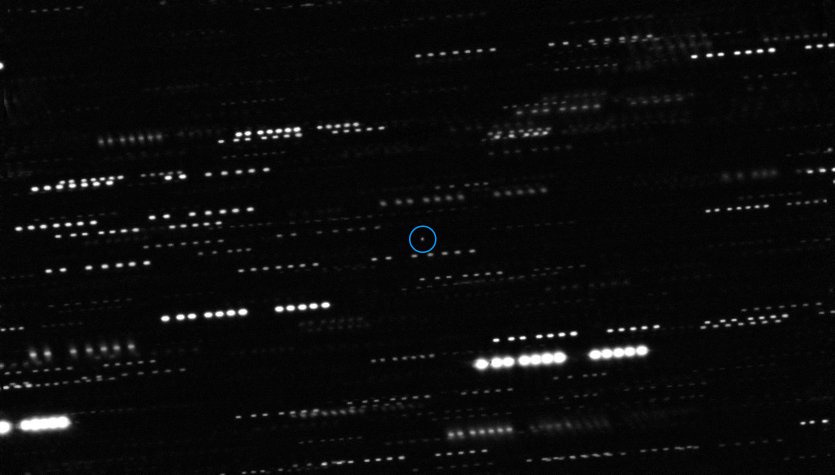
|
Above: This is the combined images that show this dicovered interstellar object at the center of the image in the blue circle. What you see around it are the photographic trails of faint stars that are smeared as the telescopes follows the object.
Image credit: ESO/K. Meech et al., source:
https://solarsystem.nasa.gov/asteroids-comets-and-meteors/comets/oumuamua/in-depth
The 12 images combined here were taken in 45 seconds overall. The object covered about 6.2° of the observed sky each day.
By October 22, 2017, two things had become clear: the object was on a hyperbolic orbit, meaning it came close to our Sun only once and was now shooting away again, never to return near the sun. And, based on its orbit, it did not originate in our solar system at all, but instead came from another star system.
It was an interstellar object coming in and out of our solar system, the first ever observed - not the last as we will see later.
Of course, it was not a big surprise to discover an interstellar object corssing our solar system; astronomers suspected that such objects should probably exist.
Immediately after its discovery using Pan-STARRS 1, telescopes around the world, including ESO's Very Large Telescope in Chile, were called into action to measure the object's orbit, brightness and color. Urgency for viewing from ground-based telescopes was vital to get the best data, because the object appeared to move extremely fast and would soon be lost from telescope sight, leaving the solar system.
Weryk spotted 'Oumuamua a few days after its closest approach to Earth, when it had come within 0.16 AU of our planet, more than 60 times the distance to the Moon. It had passed its closest position to the Sun more than a month before, flying within 0.25 AU of our star on September 9, 2017. It had entered the solar system moving about 16 miles (26 kilometers) per second and swung around the Sun at nearly 55 miles (88 km) per second.
Astronomers had a scant four months to observe it. Even the Hubble Space Telescope lost its ability to spot it after January 2018. So, between October and January, astronomers scrambled to observe 'Oumuamua with as many telescopes as possible. In all, more than 800 observations were made. Researchers started by measuring the light it reflected, which over time allowed them to create a light curve that showed how it rotates in space, as well as offered clues to its size and shape.
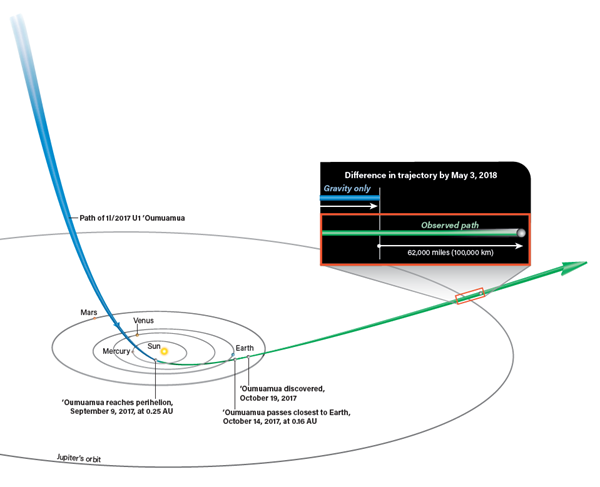
Above Trajectory of 'Oumuamua in the solar system, by Roen Kelly, in Astronomy.
Combining the images from the FORS instrument on the ESO telescope using four different filters with those of other large telescopes, a team of astronomers led by Karen Meech of the Institute for Astronomy in Hawaii found that 'Oumuamua varied in brightness by a factor of 10 as it spins on its axis every 7.3 hours.
No known asteroid or comet from our solar system that periodically varies so widely in brightness, was ever found before.
The team then stated:
"This unusually big variation in brightness means that the object is highly elongated: about ten times as long as it is wide..."
This is of course an astronomical interpretation of the brightness periodical variation. The idea was as follows: the object spins on itself every 7.5 hours, showing in succession its longer profile and its shortest aspect.
The luminosity of the object is caused by the sun lighting it. If the object had been ball-shaped, its luminosity would not vary.
But because its luminosity varied by a factor of ten, it would mean that the object was nearly ten times longer than large.
This would be an unusual shaped, as, I quote the ESO team, the "most elongated space objects seen to date were never more than three times longer than they were wide."
(See:
https://solarsystem.nasa.gov/asteroids-comets-and-meteors/comets/oumuamua/in-depth)
Below: astronomers showed the periodical change in apparent luminosity of the object in this graph:

|
This light curve recorded the brightness of the object over time. It shows the object's brightness during three days in October 2017; each color depicts measurements taken in a different filter, which views only specific wavelengths of visible or infrared light. The large dips in brightness was interpreted by astronomers as evidence that the object was long but thin, more like a cylinder than a ball. The dotted line represents the light curve of a model object that would be 10 times longer than it is wide.
Source:
Astronomy: Roen Kelly, after Olivier Hainaut (ESO)/ K. Meech et al., image at https://astronomy.com/-/media/Images/Magazine%20Articles/2020/02/ou4.png
The object would receive the name 'Oumuamua. This is a Hawaiian word meaning something like "pathfinder", or, according to the International Astronomy Union "the messenger that came from far away and arrived first"...
But the object had to get a more scientific name, and soon the enigma became apparent.
First the International Astronomy Union named it "C/2017 U1", where the "C" meant "comet." But then they renamed it "A/2017 U1", where the "A" meant "asteroid". But finally, it was renamed "1I/2017 U1", the "I" meaning "Interstellar", This was because the only thing that astronomers agreed on then was that it was an interstellar object.
Because of its spinning, it was also obvious that 'Oumuamua could not be a loose pile of rubble; the spin would have broken it in pieces. It had to be something "solid". As put by Lee Billings in a December 11, 2017, article available on the Website of the Scientific American Website:
So far there are few if any wholly satisfactory explanations as to how such an extremely elongated solid object could naturally form, let alone endure the forces of a natural high-speed ejection from a star system - a process thought to involve a wrenching encounter with a giant planet.
At the SETI institute (Search for Extra-Terrestrial Intelligence), it was thought that the object could be an extraterrestrial craft, and they "listened" to it with their ATA and GBT radio telescopes to detect possible radio emissions. But there wasn't any.
While many astronomers and commentators scoffed at SETI's attempt, and scoffed at the idea that the thing could be an extraterrestrial device, deemed "improbable" (without any reasoned justification for this "improbability"), the media published a lot of articles about the discovery, sometimes with a sensationalist tone, sometimes a mocking tone about the idea that it was an alien device.
The general public was widely confronted with this image:
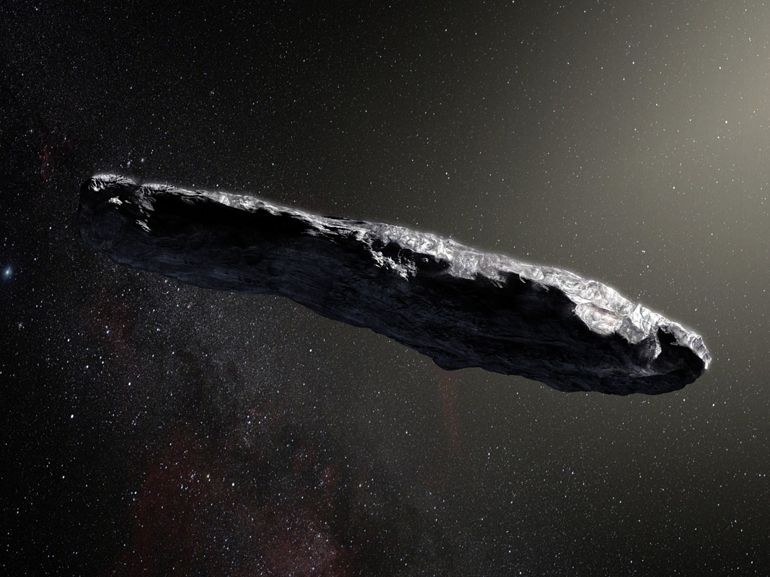
|
It was supposed to represent 'Oumuamua. Without very serious justification, it appears there as a very natural asteroid, with a rocky aspect, and elongated. I can only hope no one mistook this for an authentic photograph of the object!
(Most websites would show the image without specifying that it was just an "artist's impression"!)
As we have seen, the object was first called "C/2017 U1", as if it was a comet.
But the team of astronomers led by Karen Meech of the Institute for Astronomy in Hawaii wrote:
"We also found that it had a reddish color, similar to objects in the outer solar system, and confirmed that it is completely inert, without the faintest hint of dust around it."
The important part is: "it is completely inert, without the faintest hint of dust around it." This means that it is not a comet, or at least, it does not appear to by what we usually call a comet.
What was meant by "completely inert, without the faintest hint of dust around it "was that it was not emitting any gases, not emitting any vapor. Unlike comets who emits those, the cause of their "tail" that sometimes makes them visible even to the naked eye. It suggested that 'Oumuamua was a dense body, without water or ice or gas. It was proposed that the reddishness of its surface was due to the effects of irradiation from cosmic rays over hundreds of millions of years. Other factors could explain the reddishness, common on Asteroids and comets: patches of organic material such at tholins; iron deposits on the surface; or micrometeorites that alter a body's properties over time.
It was because Karen Meech's team contacted the Minor Planet Center to inform them that there was no observed degassing on Oumumua, that they reclassified from comet to asteroid on October 26, 2017.
One would think that it was not possible to say much about 'Oumuamua's size. Not knowing what it was made of exactly, one could have guessed it was rocky and give a size estimate based on the luminosity it reflected.
But there was a way to learn about the size: 'Oumuamua passed quite near the Sun, and the Spitzer space telescope, pointed there, would have noticed its heating by the Sun. It did not.
This meant that it was not a very big object. Astronomer Abraham Loeb (aka Aby Loeb or Avi Loeb) considered this and estimated that the object was about 100 meters long and 10 meters wide, if it was really cigar-shaped. And this was a maximum.
Astronomers interpreted the shape of 'Oumuamua as elongated. While the interpretation is certainly plausible, there was another possibility, apparently no considered because it would raise even more questions than the elongated shape.
'Oumuamua could have been a flat objects, for example, a flat disc. Or any flat object, a square, a triangle. By presenting its surface and then its edge, periodically, this would also account for the variation of luminosity.
But I guess astronomers preferred the "cigar-shape" to the "saucer-shape" because, however odd, the cigar shape appears more natural for a natural object than a flat disc shape, hardly explainable as something natural. So let's just keep the flat disc shape possibility in the back of our minds for now.
In June 2018, the scientific journal Nature published a paper by Marco Micheli of the European Space Agency's Space Situational Awareness Near-Earth Object Coordination Centre in Frascati, Italy, who had found with others that 'Oumuamua was not moving as an asteroid should. Instead, 'Oumuamua's path indicated a "really strong nongravitational acceleration," as Karen Meech, co-author on the paper, told.
This acceleration was not direction to the sun but against the Sun; 'Oumuamua accelerated away from the Sun.
Gravity was not the only thing dictating 'Oumuamua's motion. Something was causing it to speed up as it departed the solar system...
The conundrum this created is apparent in this quote from an article about 'Oumuamua on the NASA Website:
While originally classified as a comet, observations revealed no signs of cometary activity after it slingshotted past the Sun on Sept. 9, 2017 at a blistering speed of 196,000 miles per hour (87.3 kilometers per second). It was briefly classified as an asteroid until new measurements found it was accelerating slightly, a sign it behaves more like a comet.
Oops.
No sign of cometary activity, so it cannot be a comet, so it must be an asteroid, but it is accelerating slightly, so it must be a comet.
Let me explain.
An asteroid would strictly follow the rules of gravity, as an inert body. But a comet behaves a bit differently. Under the heating of the Sun, it would eject gasses, vapor, as it it had its own jet engine, or jet engines, and thus, the trajectory that would be a mystery if it were an asteroid can be explain if it is a comet.
But it was clearly observed that it was not a comet...
This is the second odd feature of Oumuamua. It must have a bizarre shape, either elongated or flat, and also, it must have some sort of mechanism that an inert rocky body does not have, so that its deviation from the expected trajectory for an inert body can be explained.
At this stage, or course, some ufologist would certainly exclaim:
"Are you kidding me? This is either a cigar-shaped or a saucer-shaped object, with its own propulsion system! We have been telling about such things for decades now!
But it is not so simple.
First, the team lead by Marco Micheli of the European Space Agency had to check for possible natural causes of the deviation.
They listed 8 possible causes, including "friction or drag" changing its trajectory, the possibility that 'Oumuamua was actually two or more objects tugging on each other, a strong magnetic field within 'Oumuamua interacting with the solar wind, and pressure from solar photons pushing on 'Oumuamua to speed it up.
They rejected all of this. Friction or drag would pull the object toward the Sun, not speed it up in the opposite direction. Images of 'Oumuamua showed no additional objects large enough to affect its motion in the way astronomers saw. And even a high magnetic field would not cause enough interaction with the Sun's charged particles to push 'Oumuamua as observed.
Then came the best:
The team explained that for solar photons to push 'Oumuamua hard enough, the space rock would need an incredibly low density, like that of aerogel, a substance that can be up to 900 times less dense than water.
In short: the pressure of the photons from the Sun would explain the anomaly of the acceleration of 'Oumuamua, admitted that this object was of such a low density that it is not at all an asteroid or a comet or anything science knows so far.
Without further ado, here is the solution proposed by these astronomers:
'Oumuamua could be a photosail.
A spacecraft could use the light emitted by a powerful laser beam or some other powerful source of light, aimed at a "sail", to be propelled in space. This "solar sail" or photosail has to be very Flat, even very thin, and highly reflective - so as not to heat up and burn.
Read again what the ESA team told:
"...for solar photons to push 'Oumuamua hard enough, the space rock would need an incredibly low density, like that of aerogel, a substance that can be up to 900 times less dense than water...
In short, an incredibly thin, highly reflective body, with a large surface area, just like... a photosail.
Now, there is even better stuff to marvel at.
Avy Loeb and Shmuel Bialy are not "crackpots". Avy Loeb is astrophysics professor at Harvard University, he directs the Astronomy department since 9 years. He authors 6 books and more than 800 scientific papers.
But there is even more to it. Avy Loeb did not just come up with the solar sail solution out of the blue.
He is actually one of the participants, from the beginning, of the famous "Breakthrough Starshot" project.
In short, Aby Loeb was "the" man who would the most logically come up with the photosail solution to the 'Oumuamua mystery.
The feasibility of the study became a science paper, peer reviewed and published in the scientific journal Astrophysical Journal in October 2015.
Iouri Milner gave a lecture about the positive outcome of the study, along with Avy Loeb, Stephen Hawking and Freeman Dyson in New York City on April 12, 2016.
A few paragraph above, I wrote "Now, there is even better stuff to marvel at." This does not stop.
Browsing through Aby Loeb's science papers available for free at arxiv.org, I found out that James Guillochon and Abraham Loeb wrote a paper titled "SETI via Leakage from Light Sails in Exoplanetary Systems".
The paper's abstract reads:
The primary challenge of rocket propulsion is the burden of needing to accelerate the spacecraft's own fuel, resulting in only a logarithmic gain in maximum speed as propellant is added to the spacecraft. Light sails offer an attractive alternative in which fuel is not carried by the spacecraft, with acceleration being provided by an external source of light. By artificially illuminating the spacecraft with beamed radiation, speeds are only limited by the area of the sail, heat resistance of its material, and power use of the accelerating apparatus. In this paper, we show that leakage from a light sail propulsion apparatus in operation around a solar system analogue would be detectable. To demonstrate this, we model the launch and arrival of a microwave beam-driven light sail constructed for transit between planets in orbit around a single star, and find an optimal beam frequency on the order of tens of GHz. Leakage from these beams yields transients with flux densities of Jy and durations of tens of seconds at 100 pc. Because most travel within a planetary system would be conducted between the habitable worlds within that system, multiply-transiting exoplanetary systems offer the greatest chance of detection, especially when the planets are in projected conjunction as viewed from Earth. If interplanetary travel via beam-driven light sails is commonly employed in our galaxy, this activity could be revealed by radio follow-up of nearby transiting exoplanetary systems. The expected signal properties define a new strategy in the search for extraterrestrial intelligence (SETI).
The paper was accepted for publication in a professional science journal after peer-reviewing (in the Astrophysics Journal).
The paper was written on... 3 September, 2015. This means that two years before the discovery of 'Oumuamua, Loeb had already guessed that it would be possible some day to find alien photosails inspace, even around other stars than ours!
17 months laters, 'Oumuamua was discovered.
Of course, the photosail solution to the 'Oumuamua anomalies offered by Avy Loeb and Shmuel Bialy was "rejected" by the "scientific community".
Of course, I wondered why, and, expecting to find a "better" solution, one that would not need "aliens", I looked for what the opponents of the photosail idea were offering as alternative.
Well, I was quite surprised that what they opposed seemed a bit week.
Check the Astronomy magazine article at:
https://astronomy.com/magazine/2020/02/our-first-interstellar-visitor
An article there recalls the 'Oumuamua story, mentions the solar sail solution in one line, and says:
Although the idea that 'Oumuamua is an alien spacecraft or abandoned extraterrestrial technology is certainly exciting, Meech and others argue it is extremely physically unlikely, especially given that one explanation the team investigated did work quite well: “The only thing that was left, which was the most logical, is that it's outgassing," Meech says.
Outgassing is the escape of gas and dust as ices on the surface of a comet sublimate, turning directly from a solid to a gas as the object approaches the Sun and heats up. The escaping gas gives the comet an extra push in the opposite direction. “This was the same level of strength as you would typically see in comets,” says Meech of 'Oumuamua's acceleration, if it were losing about 2.2 pounds (1 kilogram) of material each second. Based on what we know about solar system comets, that's not unusual. And, after all, astronomers had expected 'Oumuamua to be a comet in the first place.
Now what about the fact that no degassing was ever observed on 'Oumuamua?
The article does say:
But 'Oumuamua still had no tail, even in the deepest observations. Meech was part of a team looking for gas escaping 'Oumuamua, including CN, CO, CO2, and H2O. CN gas, which is bright and easy to spot, gets dragged off comets in our solar system when water leaves the surface, Meech says. It can be used as a proxy for water, which is harder to observe. The team also expected a fair bit of CO and CO2 because, as 'Oumuamua zipped farther from the Sun, temperatures dropped and water became harder to sublimate from the surface.
The researchers tracked 'Oumuamua for 30 hours with the infrared-seeking Spitzer Space Telescope, but nothing showed up. That was strange, because they expected “a fair bit” of gas, particularly water - and, thus, CN - to be escaping if 'Oumuamua's acceleration was due to outgassing, Meech says.
And:
But despite their sensitive measurements, "there was no CN at all seen. And that upper limit was strong enough that if there was that much water coming off, it says this comet's also unusual, chemically," she says. After all, comets in our solar system can be pretty abundant in water.
"It's always a little bit tricky to interpret too much out of not seeing something,” she cautions. But still, "it's not quite hanging together as a typical comet."
Then, we are told what 'Oumuamua would be:
"'Oumuamua is probably an ejected planetesimal or building block from the birth process of planets," Meech says.
Interestingly enough, we then learn that...
Coryn Bailer-Jones of the Max Planck Institute for Astronomy in Heidelberg, Germany, calculated 'Oumuamua's track - which originated in the direction of Lyra the Harp - back to before it first entered the solar system. His calculations rewound the clock several million years to compare 'Oumuamua's path to the past positions of 7 million stars in the Milky Way measured by the Gaia satellite. Because stars are moving in the galaxy over time, he had to rewind their orbits, in addition to 'Oumuamua's, to look for places where the two might reasonably overlap.
This is certainly a good idea. But:
He found four possible candidates that passed close enough to the rewound track of 'Oumuamua's motion that they might be its birthplace. "Close enough," Meech says, means Bailer-Jones identified stars within 1 to 2 Oort Cloud radii - 100,000 to 200,000 AU - of 'Oumuamua's path. But a close encounter doesn't necessarily mean that star is 'Oumuamua's point of origin. Furthermore, the encounters showed that 'Oumuamua would have been ejected from its home system with a high velocity, between about 6 and 16 miles (10 and 25 km) per second. "It's pretty hard to get ejection velocities this high just from a planetesimal getting too close to giant planets (in the same system)," Meech says. That process would have sent 'Oumuamua zipping away at only a few miles per second. And none of the four stars have known planets.
The high speed would be more likely, she says, if 'Oumuamua came from a binary star system. But none of the four candidates are binaries. “So, while these were our best candidates, none of them stood out as, 'This is it! This is the home system!' ” she says. The next Gaia data release - expected in late 2021 - may help, allowing astronomers to trace back the motions of even more stars and possibly find better candidates. “It would be great to revisit this in a couple of years,” Meech says, when more data are available. But for now, astronomers are unable to pin down just where 'Oumuamua came from.
So, the "degassing" is some unknown chemistry process never seen and never imagined before, and impossible to observe, and the extrasolar system from where the interstellar object came is nowhere to be found, so far at least.
Worse, "It's pretty hard to get ejection velocities this high just from a planetesimal getting too close to giant planets..." Of course, this would not be a problem at all if one would consider that 'Oumuamua is a photosail...
Then a proposal was put forward: perhaps 'Oumuamua was not rich in dust, carbon monoxide, water, or carbon dioxide, but rich in hydrogen gas. If molecular hydrogen covered merely 6% of the surface of 'Oumuamua, scientists Darryl Seligman and Greg Laughlin calculated, the sublimation of those ices once 'Oumuamua entered our Solar System could have caused the excess acceleration, all while avoiding detection by even our best instruments of the day.
But a big problem came up: hydrogen ice sublimates away very quickly, even in interstellar space. By the time even 100 million years goes by, approximately the amount of time it would have taken for 'Oumouama to hop from one star to another nearby star, it would have evaporated entirely even if it had been many times bigger. And keep in myind that it obviously did not come from a nearby star.
Aby Loeb and Thiem Hoang discarded this hydrogen gas solution in their paper "Destruction of molecular hydrogen ice and Implications for 1I/2017 U1".
I found no published objection to this paper so far. On the contrary, it seemed accepted as correctly discarding the hydrogen gas solution; I found out many popular science articles on Astronomy websites where it was presented as valid.
But another candidate compound was then proposed: molecular nitrogen (N2) ice. Nitrogen ice exists abundantly on large outer Solar System objects including Pluto and Triton. It was this proposed that a chunk of such a body was thrown away from some other star system and reached ours.
But again, a paper by Amir Siraj and Abraham Loeb checked and rejected this possibility:
Abstract: Recently, a nitrogen iceberg was proposed as a possible origin for the first interstellar object, 1I/2017 U1, also known as `Oumuamua. Here, we show that the mass budget in exo-Pluto planets necessary to explain the detection of `Oumuamua as a nitrogen iceberg chipped off from a planetary surface requires a mass of heavy elements exceeding the total quantity locked in stars with 95\% confidence, making the scenario untenable because only a small fraction of the mass in stars ends in exo-Plutos.
I found no published objection to this paper so far.
It looks like the attempts to discard the photosail solution seem to make it just a bit better every time.
On October 12, 2019, the second interstellar visitor to enter our solar system was detected by the Hubble Space Telescope. It was even imaged (below, credit NASA, ESA, and D. Jewit, UCLA).
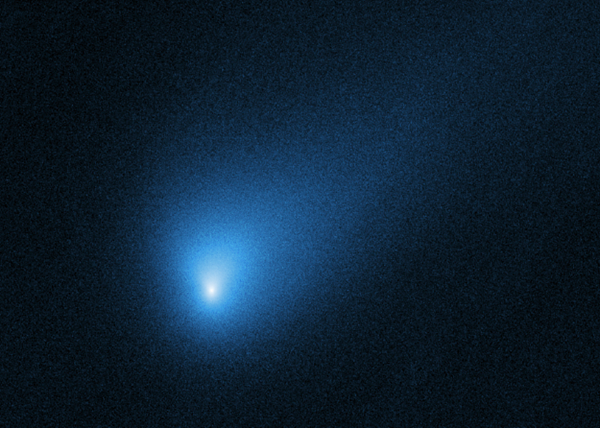
|
It was named "Comet 2I/Borisov" and it clearly shows its tail, unlike 'Oumuamua.
Astronomy said:
Meech's team has already observed the object and estimates its size between 1.2 and 10 miles (2 and 16 km). They've already spotted CN gas coming off its surface, although the comet was still too faint in October 2019 to detect other gases, she says. But “with 2I, we have a really long observing period of a year,” Meech says. That will allow astronomers to explore its chemistry - unlike 'Oumuamua - even if, she says, the comet's gas and dust may hinder attempts to get a good handle on the shape and size of its nucleus. But ultimately, [2I] looks like a comet, and it's red, and it's got CN.”
That means it looks very much like a typical solar system comet - and paints a very different picture of an interstellar traveler than 'Oumuamua. But those differences are valuable for astronomers trying to learn more about how other solar systems form, whether they are like or unlike our own.
Which makes the solar wind solution for 'Oumuamua, again, a litttle stronger.
No, it is not a proven fact that 'Oumuamua is an alien photosail or some other alien artefact. Avy Loeb does not claim it is. He only explains why the photosail solution should not be discarded.
What is striking for Avy Loeb, and myself, is that the whole issue is a matter of opposing what is "probable" or not. Many astronomers now would agree that there is very little justification in claiming that we can only be the only intelligent beings in the galaxy. Many would agree that it is improbable, given what we already know, that life exists only on one planet, ours, when there are apparently planets around almost every stars, and at least 1 habitable planet around 1 of 10 stars, and at least 200.000.000 stars in our galaxy alone, and between 200.000.000 and 100.000.000.000 galaxies in the observable universe, amounting to at least 1.000.000.000.000.000.000.000.000 stars. It seems to me that it would be highly improbable that life appeared and underwent Darwinian evolution leading to intelligent and technological species only on one planet. But, oddly to me, many still use the "improbable" argument to prefer any solution, however improbable, that does not imply that we are not alone.
The notion that 'Oumuamua could be a photosail was never discarded on its own merits; it was only discarded under the motive that an alien photosail must be, for whatever reason that escapes me, "improbable", and that any other solution is better, even when it is not proven or when it is only mildly plausible.
Ockham's razor? A good principle, provided that it was demonstrated beforehand that "aliens" are really "improbable" rather than "probable". Where is this demonstration?
I am not an astronomer, I am a ufologist. I see the same issue with some UFO sighting reports. For some people, they must all be misinterpretations and hoaxes, because any explanation must be preferred to "aliens". Aliens are "improbable", right?
It is unlikely that we will ever know for sure what 'Oumuamua was. But maybe interstellar bodies will be checked out better in the future. Actually I am quite sure they will.
Avi Loeb told the 'Oumuama discovery and controversies and explained his solution in a book, making it more readable to the general public. He also discussed features of 'Oumuamua that reinforce his solution that I did not intruduce here (such as its position in the LSR).
Whereas I only gave the highlights of the story in this Web page, the book tells more about it.
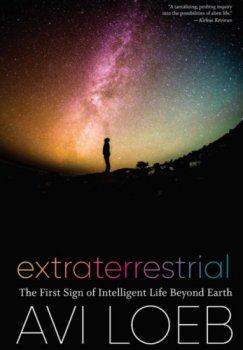
|

|